
Review: Korg Volca FM2
Three extra voices, velocity sensitivity and a reverb headline the FM2 upgrades.
Review: Christopher Holder
Korg Volca is more than a range of mini synths, it’s more like an ecosystem — well regarded by synth aficionados everywhere. Sure, a Korg Volca is a nifty standalone synth, but it really comes into its own when interconnected, in fact, you can buy the whole fam and pop it into a three-tiered Volca rack if you’re super keen. In other words, there’s a Volca for all occasions, including an FM-voiced Volca.
Now, the original Volca FM has been superseded. The new FM2 model adds three extra voices and reverb. Otherwise it still employs six operators — with 32 available algorithms (modulator/carrier combinations) to choose from.
MONSTER HIT
FM synthesis became a monster hit in the early ’80s, mostly because it sounded so different to the analogue subtractive synths of the day. It was fresh, digital and snappy.
FM synthesis excels in percussive sounds (bells and the like), glassy textures and slappy basses. Yamaha’s DX7 is still the gold standard in FM. In fact, Volca FM can accept sysex data from the DX7… remarkable really, given Yamaha stopped making the synth more than 30 years ago!
If you want to hear FM and the DX7 in action then look no further than Kenny Loggins ‘Danger Zone’ bassline from the original Top Gun, the bassline from A-ha’s ‘Take on Me’ is also classic DX7, the harmonica solo from Tina Turner’s ‘What’s Love Got to do With it’ and too many others to mention [see box item for more]. The reason why the DX7 is so easily identified in those monster pop songs was because they invariably used the factory presets. Why? Because the DX7 was notoriously impossible to program.
To Korg’s credit, with the recent release of its OpSix, it went where no other hardware synth had previously gone before: a FM synth that is actually possible to program. The Volca FM2 doesn’t share the OpSix’s colour-coded operator/modulator sliders and oLED with the algorithm configurations but it does have some Volca pots for diving into what Korg believes to be the most oft-used parameters, including Modulator Attack and Decay, Carrier Attack and Decay and LFO control. Then there’s the Algorithm pot, which is a winner when it comes to experimentation. (No one really expects you to have any idea what will happen when you cycle through the 32 possible algorithms, but I think that’s the point.) There’s a slider for global velocity that doubles as a handy Value controller when editing menu items. The other slider is a transpose control, which seems a bit unnecessary given the Octave buttons work just fine.
Deep-dive parameters are, mercifully, documented on a handy ‘flash’ card, including the multi-stage envelope generator.
The arpeggiator is simple but welcome. (Change patches and the arp remains on — which I couldn’t decide was a pro or a con.) The 16-step Korg sequencer is familiar, as is the Motion Sequencer, a Korg favourite since the original Electribes, that allow you to record your tweaks along with your sequenced performance.
NEED TO KNOW
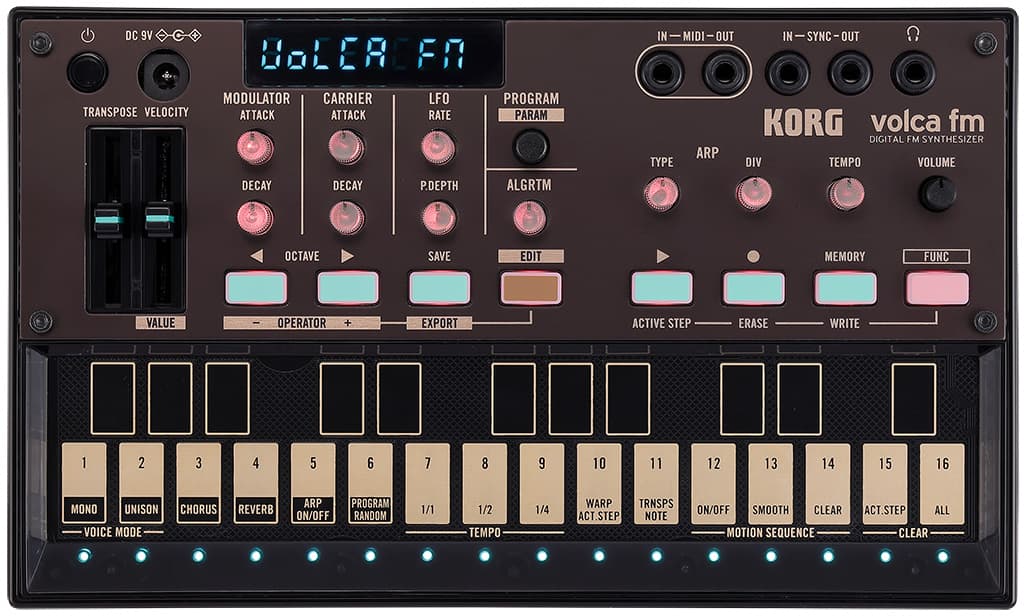

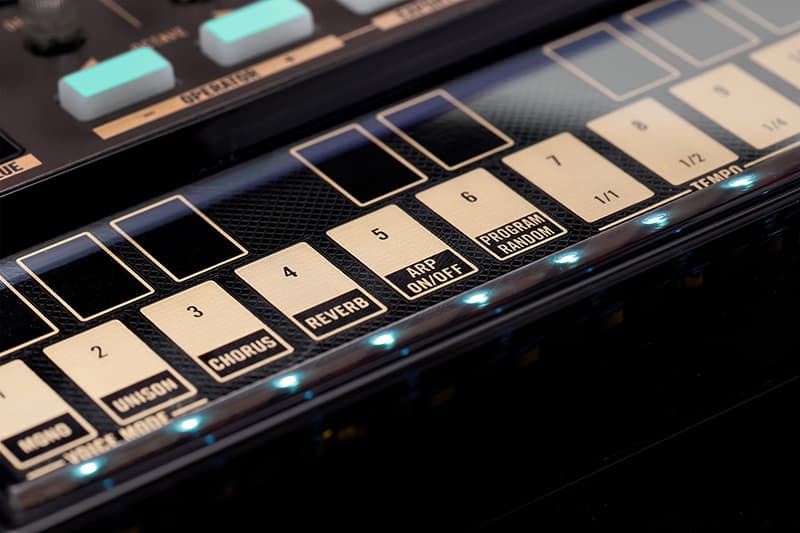
TRIUMPHS & TRADE-OFFS
This is a Volca and the UI trade-offs are well known. The LED screen is super basic, for example. Other quirks like running on battery power (no PSU supplied, but batteries are) and the cancelling of the full-size DIN MIDI sockets, I’d braced myself for. (That said, there’s now a MIDI Out, which some will find useful.) This is the Volca way and the pricing and sound conspire to have me turn a blind eye.
The presets are a combination of FM faves and a smattering of interesting sound designer easter eggs. The presets just as effortlessly poke through a mix as they did back in 1981. But the FM2’s three extra voices over the original Volca FM allows more serious electric piano work (Peabo Bryson, anyone?), and the new reverb beefs up the FX section (supplementing the original chorus effect).
FM is an almost indispensable texture to have in your sonic palette, and not just for making a Cobra Kai soundtrack or dabbling in synth wave. The Volca FM might be a bona fide FM mini monster but it’s not just a homage to the ’80s. It’s also bang up to date.
Enjoy.
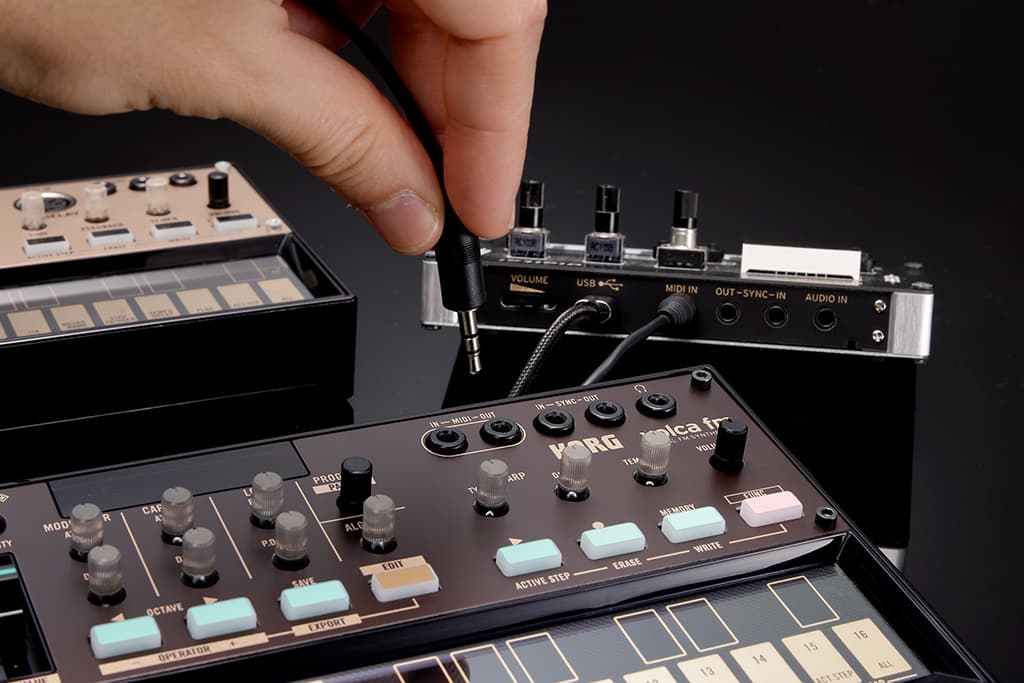
FM/DX7: SOUND OF THE ’80S
1983 Howard Jones — What is love (Bass & Bells)
1984 Commodores — Nightshift (Bass Fretless Mod wheel)
1984 Bronski Beat — Smalltown Boy (Patch Double Harp)
1984 Eric Carmen — Hungry Eyes (Bells)
1984 John Parr — St. Elmo’s fire (Man in motion) (E. Piano & Bass)
1984 Glenn Frey — You belong to the city (Bass & E. Piano)
1984 Wham! — Everything She Wants (Synth Bass)
1984 Laura Branigan — Self Control (Bells)
1984 Billy Idol — Eyes Without a Face (Bells)
1984 Daryl Hall & John Oates — Out of Touch (Bells & Bass)
1984 Foreigner — I Want to Know What Love Is (Bells & Strings)
1985 Dead or Alive — You Spin Me Round (Organ & Bass)
1985 Bryan Adams — Heaven (Piano & E. Piano)
1985 A-ha — Take on Me (Bass & Bells)
1985 USA for Africa — We are the World (Piano Bells & E. Piano)
1985 Robin Gibb — Like a Fool (Bells & Bass)
1985 Starship — We Built This City (Slap Bass & Piano/Bells)
1985 Tears for Fears — Everybody Wants to Rule the World (Bass)
1985 Baltimora — Tarzan Boy (Bass & Trumpet)
1986 Queen — Who Wants to Live Forever (Orchestra)
1986 Kenny Loggins – Danger Zone (E. Bass)
1986 Lionel Richie — Say You, Say Me (Bass & Bells/Strings)
1986 Berlin — Take my Breath Away (Fretless Bass)
1986 Cutting Crew — (I just) Died in Your Arms (Flute et al)
1986 Cyndi Lauper — Change of Heart (Bass & Bells)
1986 Bon Jovi — Livin’ on a Prayer (Strings/Bells)
1986 Toto — I’ll be Over You (Piano Bells)
1986 Survivor — Is This Love (Piano/Brass)
1987 Starship — Nothing’s Gonna Stop us Now (Bass & Bells)
1987 Rick Astley — Never Gonna Give You Up (E. Piano & Bass)
1987 Stevie Wonder — Skeletons (E. Bass)
1987 Johnny Hates Jazz — Shattered dreams (Bass & Piano/Bells)
1988 Kylie Minogue — I Should be so Lucky (Bass & Bells)
1989 Debbie Gibson — Electric Youth (E. Bass)







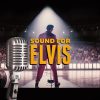
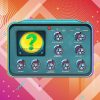














RESPONSES